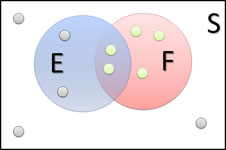Conditional Probability
The notation P(F|E) is read "the probability of F given E" and represent the probability that event F occurs, given that event E has already occurred.
Example 1
Consider the experiment where two cards are drawn without replacement. (Without replacement means one is drawn and then the second is drawn without putting the first one back.) Define events E and F this way:
E = the first card drawn is a King
F = the second card drawn is a King
Find P(F|E).
ANSWER
P(F|E) is the probability that the second card is a king given if the first card drawn was a king. In that case, there will be 3 kings left out of 51 cards, so
P(F|E) = 3/51
It can be helpful again to look at a Venn diagram to illustrate the idea. Let's look at this one that we used back in section 5.2.
Example 2

Find P(E|F).
ANSWER
OK, this is a little trickier. P(E|F) is the probability that event E occurs given that event F has already occurred. Let's change the image a bit. Since F has occurred, we can focus on just those "outcomes" in F.

And then of those, we want the probability that the "outcome" is in E. Since there are 2 of those in E, and 5 total,
P(E|F) = 2/5.
One more example.
Example 3
Let's consider a survey given to 52 students in a Basic Algebra course at ECC, with the following responses to the statement "I enjoy math."
| Strongly Agree | Agree | Neutral | Disagree | Strongly Disagree | Total | |
| Male | 6 | 10 | 3 | 0 | 0 | 19 |
| Female | 8 | 14 | 7 | 4 | 0 | 33 |
| Total | 14 | 24 | 10 | 4 | 0 | 52 |
What is the probability that a student enjoys math (Agree or Strongly Agree) given that the student is a female?
ANSWER
There are 33 female students total. Of those, 22 responded that they enjoyed math, so...
P(enjoys math | female) = 22/33 = 2/3

No comments:
Post a Comment